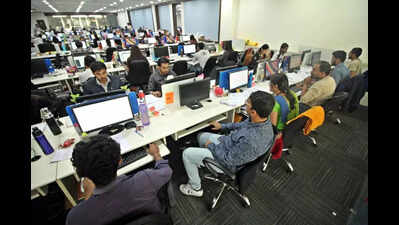- News
- City News
- delhi News
- Addressing office discomfort: The impact of centralised air-conditioning on employee well-being and productivity
Trending
Addressing office discomfort: The impact of centralised air-conditioning on employee well-being and productivity
Centralised air-conditioning causes discomfort in offices. Employees experience temperature fluctuations. Some feel cold, others feel hot. The one-size-fits-all approach is the problem. Experts suggest smarter climate control systems. They recommend better insulation and efficient windows. Adjusting temperature setpoints is also crucial. Employers should consider employee feedback. Addressing AC issues improves health and productivity.
NEW DELHI: The daily office grind comes with its fair share of challenges, but one surprisingly common, and often ignored, problem is the extreme discomfort caused by centralised air-conditioning.
Walk into any office, and you'll find one group of employees bundled in sweaters and scarves, while others fan themselves at their desks. This bizarre temperature tug-of-war isn't just uncomfortable. It's a drain on productivity and well-being.
"It's like working inside a refrigerator," laughs Deepali Raina, who works at a real estate services firm. "I always keep a jacket at my desk, even in peak summer." She's not alone. Several employees report similar experiences. Some even go as far as taping the AC vents with paper or cardboard to protect themselves from the icy blast. "People fall ill often because the temperature fluctuates too much," says Piyush Amola, an IT consultant. "I've seen colleagues shivering in one room while the meeting room right next door almost feels like a sauna."
At the heart of the problem is the one-size-fits-all approach of centralised air-conditioning systems.
Another culprit is overly low temperature setpoints — most systems are fixed at 18-21°C, far colder than what's actually needed for comfort. "This leads to very cold conditions in many buildings," he added. What's worse is that many Indian office buildings are plagued by design inefficiencies like leaky windows, poor insulation, and too much direct sunlight on certain facades. These structural issues cause heat gain in some areas while others remain chilled, leading to a chaotic climate control scenario.
But even when the thermostat seems to be set at a "comfortable" temperature, why do some people still feel cold and others hot? "The perception of thermal comfort is complex," Dr Akhilesh Arora of Delhi Technological University said. "It does not depend just on the air temperature, but also on humidity, airspeed, activity level, clothing, age, sex, metabolic rate, body composition and even psychological factors."
For instance, someone eating spicy food or performing a physically demanding task may feel warmer than someone quietly working at a desk. Older employees often feel colder than their younger counterparts due to differences in body composition and circulation. Similarly, stress or anxiety can alter how one perceives temperature, making someone feel hotter or colder than they actually are.
"There can't be any generalised conditions in which all individuals will feel comfortable," Dr Arora said. What might be the perfect temperature for one team could feel unbearable to another just down the hall. Experts agree that smarter, more adaptive climate control systems are the key. "Air distribution and installed cooling capacity must be carefully evaluated in different parts of the building using scientific methods and best practices," Goyal said. Instead of blasting cold air uniformly, systems should use intelligent controls that sense room occupancy, outside weather conditions, and internal temperatures.
Technologies like variable speed compressors and variable air volume systems allow for better modulation of cooling loads, ensuring that air conditioning adjusts in real-time to actual requirements. These systems can target specific zones, avoiding unnecessary overcooling or overheating in underused areas. Another game-changer is integrating AC systems into the design phase of buildings. "Better insulation, efficient windows, and proper shading can minimise external heat gains and improve internal temperature stability," Goyal said. These features not only create more consistent comfort but also reduce energy bills significantly.
Perhaps the simplest, and most overlooked, solution is adjusting temperature setpoints. "Slightly higher AC temperature settings (24-25°C) can also provide thermally comfortable conditions for office workers, who are mostly seated," Goyal suggested. Office discomfort caused by poor AC settings might seem like a minor inconvenience, but it has serious implications for health, morale and productivity. Frequent temperature swings contribute to colds, fatigue and even headaches. Employees distracted by physical discomfort are less likely to focus, collaborate or feel engaged in their work.
The solution lies not just in better technology, but also in greater awareness and flexibility. Experts believe that employers must take feedback seriously, involve HVAC experts when designing or retrofitting office spaces, and avoid the outdated approach of cooling to the lowest possible temperature. A simple tweak to the thermostat might just be the smartest business decision of all.
End of Article
FOLLOW US ON SOCIAL MEDIA








